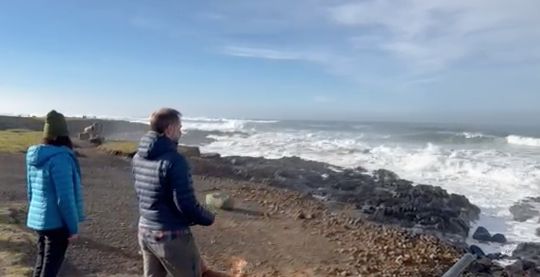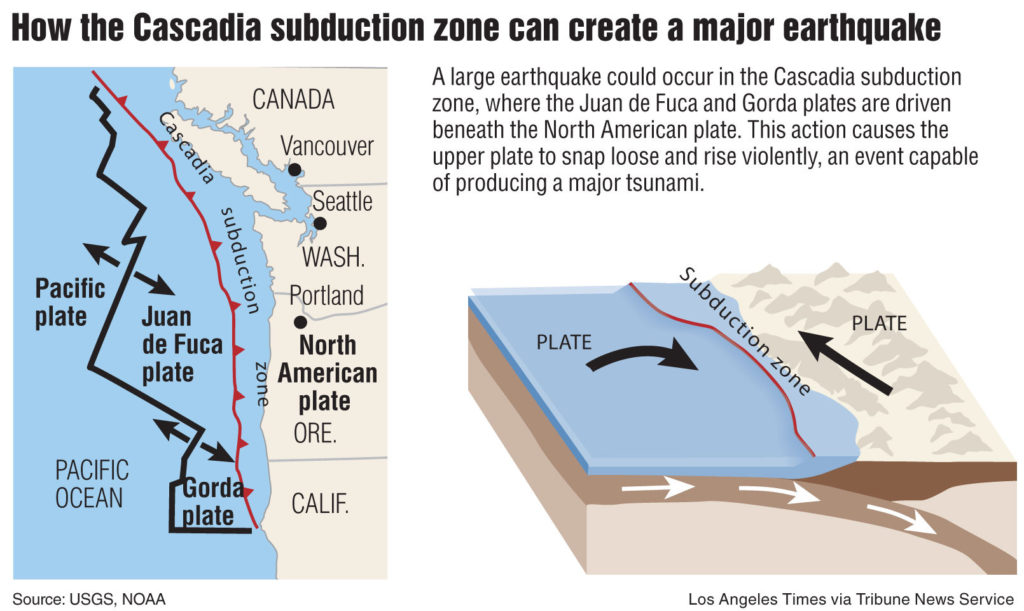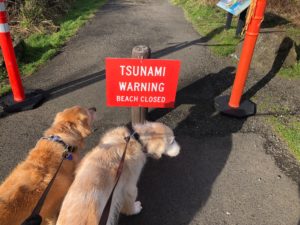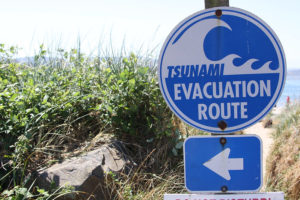
By JAMIE HALE/The Oregonian/OregonLive
The tsunami that rippled across the Pacific Ocean on Saturday may have been a good test run for the Pacific Northwest’s emergency alert systems, but it’s not yet clear how useful the experience will be in preparing Oregonians for a major disaster.
Caused not by an earthquake but a massive eruption of an undersea volcano near the Pacific nation of Tonga, the explosion sent larger-then-normal swells up the Oregon, Washington and California coastline in a rare event that researchers and emergency management officials are still trying to wrap their heads around.
Stephanie Ross, a geophysicist with the U.S. Geological Survey and a tsunami scenarios coordinator with the Pacific Coastal and Marine Science Center in Santa Cruz, Calif., said the volcanic tsunami was unprecedented in the modern era and the first time the U.S. Tsunami Warning Centers have issued an alert based on a volcanic source.
“We know they’re possible but it’s just not something that we deal with very often,” Ross said. “There’s just a lot of uncertainty around a complicated event like this.”
What researchers do know is that there are a lot of differences between a volcanic tsunami far off in the Pacific Ocean and a tsunami triggered by an earthquake, especially a Cascadia Subduction Zone earthquake that Oregonians are most concerned about.
One of the biggest differences is time – as in, how much time it takes for a tsunami to reach shore and how long people have to escape.
Harold Tobin, director of the Pacific Northwest Seismic Network and a professor of seismology at the University of Washington, said coastal communities would have only five to 10 minutes to flee a tsunami caused by a major earthquake just offshore. People on the coast should evacuate immediately if they feel an earthquake, he said, and not wait for an official alert.
In contrast, communities had several hours to prepare Saturday, and while agencies sent out alerts none ordered evacuations, which proved to be unnecessary.
“Yesterday’s events are a really good test run and reminder that we need to have tsunami preparedness at the top of our minds,” Tobin said.
People should have heeded the alerts, he said, even though scientists didn’t have the usual playbook at hand with the volcanic tsunami.
For instance, he said, earthquakes are so baked into tsunami alerts that when the U.S. Tsunami Warning System issues a warning, it has to include the magnitude of the event. The volcanic eruption that caused Saturday’s tsunami didn’t have a magnitude, so officials simply input “0.1,″ he said, a figure that initially befuddled some researchers.
The unprecedented nature of the volcanic tsunami off Tonga also left officials uncertain about how long it would last, though they were able to predict how soon it would arrive. By the time waves began to swell along the Pacific coast, word had already spread across the region, aided by social media and media reports, as well as state and local alert systems.

Local warnings, but lots of lookers
The tsunami occurred on a brilliant blue Saturday morning. With at least an hour’s warning before the first waves, coastal residents were able to go watch from higher vantage points to see lines of curling waves and lasted long enough into the afternoon that inland residents could drive to the coast and see the tsunami for themselves – an activity that researchers and emergency officials all condemn.

It was a similar scene at towns up and down the Oregon coast, where people flocked to viewpoints and some beaches in coastal communities — despite explicit warnings from officials to stay away — to catch a glimpse at the incoming waves.
In Lincoln County, local fire departments and Oregon State Parks personnel closed off entrances to most parks and Highway 101 turnouts where people normally go to see ocean events.
Lincoln County emergency managers activated their countywide response system, sending sheriff’s deputies and police to potentially dangerous areas and giving regular warnings and updates via cell phones and emails.
There were no issues reported Saturday.
Deceptive ocean
Contrary to their depiction in some blockbuster movies, tsunamis don’t show up as towering, crashing waves, but as larger-than-normal swells. Shaky YouTube videos of the 2004 tsunami in the Indian Ocean, for example, offer a much better depiction of the disaster than the dramatization of the event in the 2010 movie “Hereafter.”

An inaccurate perception could lead to misplaced excitement about seeing a tsunami in person and might result in people making dangerous decisions like walking out to the beach and along jetties, or even paddling out to surf the incoming waves, Tobin said. Most people don’t have a good grasp on what a 3-foot wave actually looks like, let alone a 100-foot wave, and that might make them misjudge the danger.
Most waves in Oregon reached only about a foot or less, with the largest reported swell cresting at 1.5 feet near Port Orford, according to the National Weather Service.
But Tobin noted: “Just because (tsunamis) are traveling across the ocean from far away, and it’s not being predicted to be a massive wave, doesn’t mean there’s not danger.”
The 2011 tsunami caused by a 9.1-magnitude earthquake off the coast of Japan is a prime example. While not nearly as damaging in the Pacific Northwest as it was in Japan, the event still sent waves up to 6 feet high to U.S. shores, destroying a few marinas on the Oregon coast.
That did not happen Saturday.
Ross said while recent events should instill more caution, some people will always be drawn to the allure of tsunamis, either unaware of or apathetic to the dangers they bring.
“Sadly, it’s fairly normal,” she said. “We’ve seen enough tsunamis that we know it happens and sometimes people die because of it.”
From the public’s reaction to actions taken by state and local officials, she said it’s still too soon to do a proper postmortem on what happened Saturday and the public’s response.
“There’s a lot we have to learn from this, and I think it’s going to take a while to really work it all out,” Ross said. “I think we have our work cut out for us.”
- YachatsNews.com contributed to this report
To read about the science of the Tongo volcanic explosion, see this article by the Washington Post


